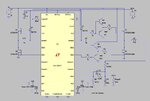tictac
Full Member level 5
Hi
I want to design the synchronous buck with LTC3858-1 with below specification
Vin=13 volts to 35 volts
Vout=1 volts to 12 volts
Iout-max=50 ampere
I want to modify the LTC3858-1.asc proper to my design. How can I modify this file for higher output power ?
Its the file of the modified schematic that comes with LTspice .
I want to know with maximum power that can be reach with Synchronous buck?
Maximum current at 1 volts output is about 7 ampere.
I prefer to complete the schematic and improve the fault in the design. I have attached the ltspice schematic for better helping. If you run the simulation you can see that the output voltage is reach to 6 volts and after some time it drops to zero because of current limiting. Can you help me for improving my schematic?
Regards
I want to design the synchronous buck with LTC3858-1 with below specification
Vin=13 volts to 35 volts
Vout=1 volts to 12 volts
Iout-max=50 ampere
I want to modify the LTC3858-1.asc proper to my design. How can I modify this file for higher output power ?
Its the file of the modified schematic that comes with LTspice .
I want to know with maximum power that can be reach with Synchronous buck?
Maximum current at 1 volts output is about 7 ampere.
I prefer to complete the schematic and improve the fault in the design. I have attached the ltspice schematic for better helping. If you run the simulation you can see that the output voltage is reach to 6 volts and after some time it drops to zero because of current limiting. Can you help me for improving my schematic?
Regards



